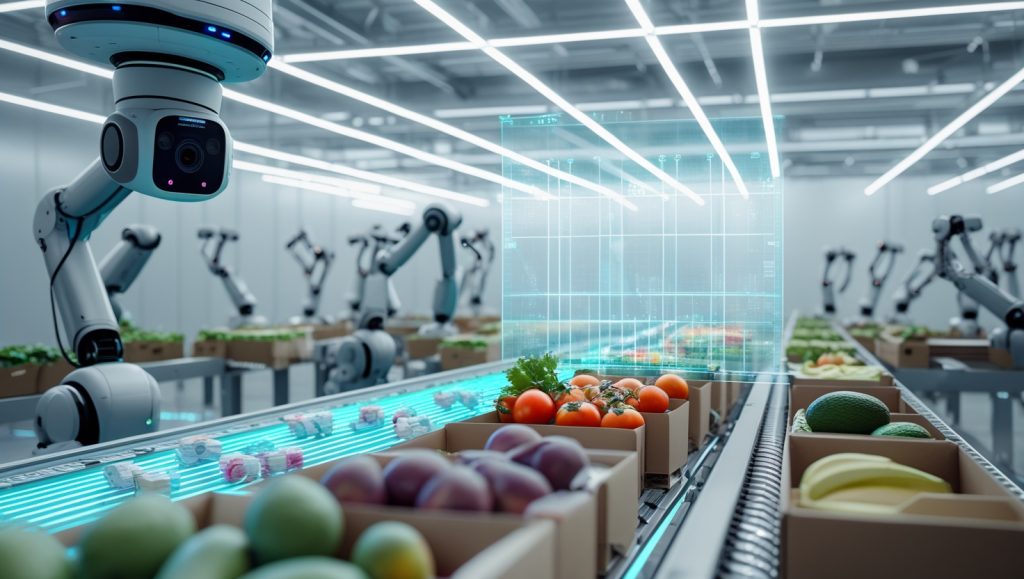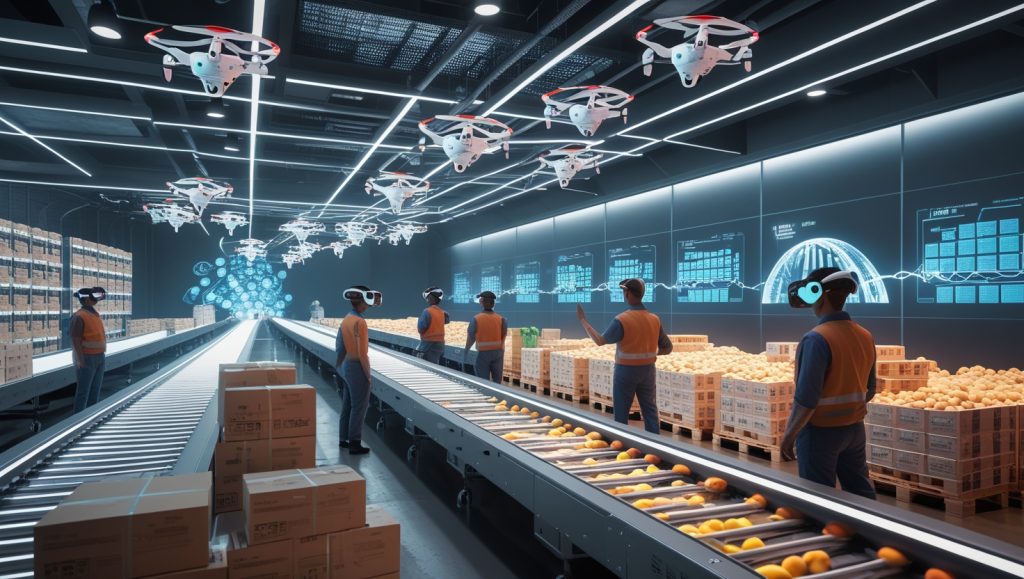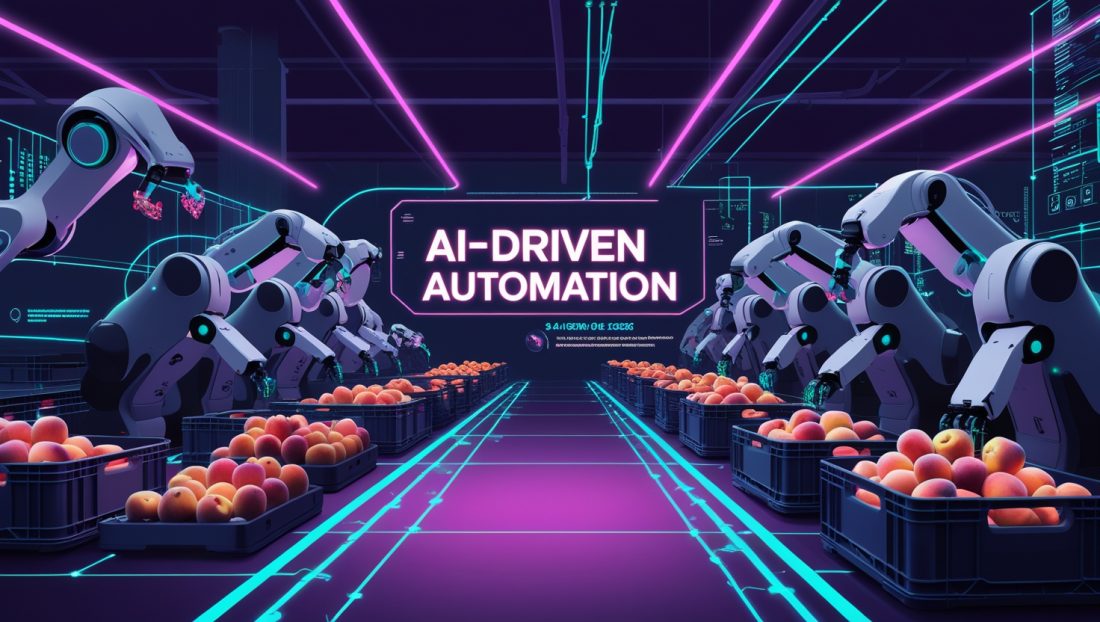The Ticking Clock of Retail Innovation
What if, in 2025, AI-powered robots could pack your entire grocery order in 90 seconds—flawlessly? The retail sector is under pressure from labor shortages, climate challenges, and soaring consumer demands for online grocery shopping. Traditional grocery packing methods are faltering, but AI-driven automation revolutionizing grocery logistics offers a solution. Enter the AI-powered robot army: a fleet of intelligent machines transforming grocery fulfillment and logistics. This isn’t just about speed/efficiency—it’s about survival in a $12 trillion industry, driving a revolutionary/game-changing shift in the future of retail. For insights into automation’s broader impact, see Why Autonomous Mobile Robots (AMRs) Are Dominating.
The Urgent Need for an AI-Powered Robot Army
The global grocery market is growing by 6.3% annually in 2025, fueled by e-commerce and post-pandemic shifts toward online grocery shopping. Yet, manual packing remains error-prone, with Walmart reporting 15% of online orders containing mistakes in 2022. AI-driven automation revolutionizing grocery logistics addresses these flaws, enabling contactless fulfillment and precision inventory management to meet consumer demands for wide product selection. The AI-powered robot army is key to this revolutionary/game-changing transformation, reducing errors and enhancing scalability/modular design.
Why Automation Alone Isn’t Enough
Traditional automation, like conveyor belts, struggles with variability in grocery fulfillment. A can of beans is simple, but a ripe peach requires finesse. The AI-powered robot army, powered by computer vision and deep learning, bridges this gap. For example, Takeoff Technologies’ Customer Fulfilment Centres (CFCs) use AI-driven automation revolutionizing grocery logistics to cut packing errors by 80% while doubling throughput. This precision, combined with temperature-controlled handling, ensures quality for delicate items, setting a new standard for logistics.
Why AI-Driven Automation Outpaces Traditional Systems
The AI-driven automation revolutionizing grocery logistics leverages deep learning to adapt to diverse products, unlike rigid conveyor systems. By integrating computer vision and digital twin technology, AI-powered robots simulate packing scenarios in real time, optimizing for speed/efficiency and reduced food waste. This capability, seen in How the Flashbot Arm Is Crushing Automation, allows retailers like Kroger to handle wide product selection with unmatched precision, fueling the future of retail while addressing job disruption concerns.
Inside the AI-Powered Robot Army: How It Works

AI-driven automation revolutionizing grocery logistics powers the AI-powered robot army through advanced technologies:
Step 1: Computer Vision Scans and Categorizes Items
Using 3D cameras and spectral imaging, computer vision identifies item size, shape, and fragility. German startup Sewts’ techniques, adapted for delicate produce, enhance precision inventory management in Customer Fulfilment Centres (CFCs). This ensures temperature-controlled handling, critical for grocery fulfillment.
Step 2: Machine Learning Optimizes Packing Logic
Deep learning algorithms calculate space-efficient arrangements, prioritizing crush-resistant items. Ocado’s Hive system, a leader in AI-driven automation revolutionizing grocery logistics, reduced packaging material by 20% in 2023 with 99.9% accuracy, as explored in Why Robotics in Recycling Is Reshaping Global.
Step 3: Robotic Arms Execute With Human-Like Dexterity
Soft Robotics’ mGrip technology mimics human tendons, enabling AI-powered robots to grip irregular shapes without damage. A 2024 California pilot cut avocado waste by 30%, showcasing reduced food waste and scalability/modular design in logistics. Similarly, advancements in AI-driven automation revolutionizing grocery logistics allow robots to pack groceries in minutes, as reported by Fox News.
Why the Hive System Redefines Grocery Logistics
Ocado’s Hive, a cornerstone of AI-driven automation revolutionizing grocery logistics, uses an air traffic control system for robot coordination, ensuring speed/efficiency (e.g., 5-minute packing, 9 mph robots). This revolutionary/game-changing system, detailed in Why Service Robots in China Drive Humanoid Growth, supports contactless fulfillment and delivery route optimization, making Customer Fulfilment Centres (CFCs) a model for vertical farming and airport baggage handling.
Real-World Impact: Case Studies Shaping 2025
Case Study 1: Kroger’s Partnership With Symbotic
The Ocado-Kroger collaboration invested $200 million in AI-powered robots for Customer Fulfilment Centres (CFCs). In 2025, Kroger’s 1,000 robots across 50 centers achieve speed/efficiency with 40% faster processing and 25% lower labor costs, driven by AI-driven automation revolutionizing grocery logistics. This partnership leverages forecasting for demand prediction, enhancing scalability/modular design.
Case Study 2: Alibaba’s “Future Market” in Shanghai
Alibaba’s Hema supermarkets use AI-driven automation revolutionizing grocery logistics to pack orders in under 3 minutes. In 2023, they processed 500,000 orders daily with a 0.1% error rate, setting a benchmark for grocery fulfillment and delivery route optimization, as seen in Why Robotics Is the Secret Weapon in the Fight Against Climate Change.
Why Partnerships Amplify AI Automation’s Impact
The Ocado-Kroger collaboration exemplifies how partnerships drive AI-driven automation revolutionizing grocery logistics. By combining Ocado’s Hive with Kroger’s market reach, this partnership achieves speed/efficiency and reduced food waste, impacting vertical farming and assisted living. As discussed in Why Robot Subscription Services Are the Next Big Revenue Stream, such collaborations scale logistics innovations globally, addressing job disruption concerns.
Ethical and Operational Challenges

Workforce Displacement: A Looming Crisis
The World Economic Forum notes that AI-driven automation revolutionizing grocery logistics could displace 20 million retail jobs in 2025. However, automation creates roles in robot supervision, as Amazon’s reskilling shows. Carrefour’s AI upskilling in France, transitioning 10,000 workers, aligns with AI-driven automation revolutionizing grocery logistics, as explored in Why STEM Robotics Competitions Are Fueling.
Technical Hurdles: When AI Meets Reality
AI-powered robots struggle with edge cases (e.g., organic vs. non-organic apples). Startups like Covariant use multimodal AI and RFID tags to enhance computer vision, ensuring accuracy in precision inventory management for grocery fulfillment. These challenges highlight the future of retail’s complexity.
Why Job Disruption Concerns Demand Solutions
AI-driven automation revolutionizing grocery logistics raises job disruption concerns—is this robot after our jobs? By integrating digital twin technology and air traffic control systems, companies like Ocado mitigate risks through reskilling, as seen in Why Robots Solve the Labor Crisis and What Stops Them. This ensures scalability/modular design while supporting assisted living and airport baggage handling applications.
The Road to 2025: What’s Next?
Phase 1: Hyperlocal Fulfillment Centers (2024)
Walmart’s “Last Mile” initiative, using AI-driven automation revolutionizing grocery logistics, places Customer Fulfilment Centres (CFCs) within 10 miles of urban centers, achieving delivery route optimization and speed/efficiency.
Phase 2: Climate-Adaptive Packing (2025)
In 2025, AI-powered robots adjust packaging based on weather data, using digital twin technology to prevent spoilage, supporting reduced food waste and temperature-controlled handling in logistics.
Phase 3: Consumer-Driven Customization (2026 and Beyond)
AI-driven automation revolutionizing grocery logistics will enable robots to curate meal kits based on DNA profiles, tested by Nestlé, advancing grocery fulfillment and the future of retail.
Why 2025 Marks a Turning Point for AI Automation
In 2025, AI-driven automation revolutionizing grocery logistics transforms Customer Fulfilment Centres (CFCs) into hubs for vertical farming and assisted living. With Ocado’s Hive and deep learning, retailers achieve speed/efficiency (e.g., 5-minute packing) and forecasting, as highlighted in Why AI in Robotics Is Failing, which notes technical hurdles but underscores revolutionary/game-changing potential.
FAQs: Addressing the Public’s Burning Questions
Will these robots eliminate jobs?
While low-skill roles may decline, AI-driven automation revolutionizing grocery logistics creates tech jobs. The EU’s “Automation Readiness Index” reports 2 million new jobs in 2025, driven by automation and AI-powered robots.
Are AI robots affordable for small businesses?
Leasing models like Fabric’s robot-as-a-service, starting at $5,000/month, make AI-driven automation revolutionizing grocery logistics accessible, offering scalability/modular design for online grocery shopping.
Can robots handle fragile items like eggs?
Yes, RightHand Robotics’ suction grippers achieve a 99.8% success rate, ensuring temperature-controlled handling in grocery fulfillment with AI-driven automation revolutionizing grocery logistics.
The Revolution Is Here in 2025
The AI-powered robot army, driven by AI-driven automation revolutionizing grocery logistics, is reshaping logistics with contactless fulfillment and precision inventory management. Retailers ignoring this revolutionary/game-changing shift risk obsolescence in the future of retail.
Stay ahead of the curve. Subscribe to our newsletter for monthly updates on AI-driven automation revolutionizing grocery logistics.
